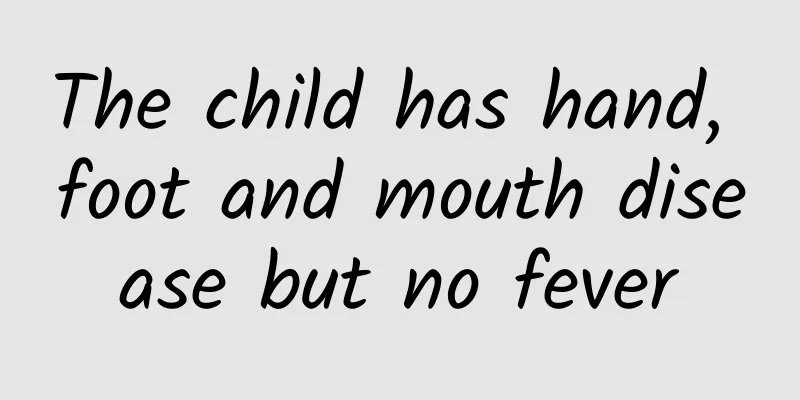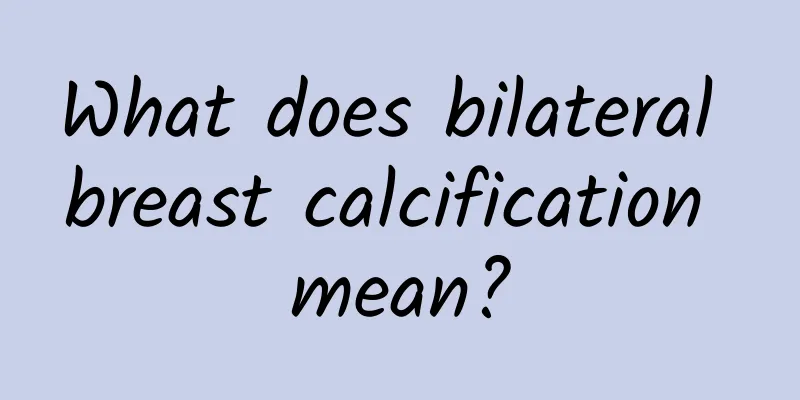The child has hand, foot and mouth disease but no fever

|
It is actually normal for children not to have a fever when they have hand, foot and mouth disease. Parents should not think that their children will have a fever after suffering from hand, foot and mouth disease, and then judge whether their children have this disease based on the fever. This is unreasonable. The symptoms of hand, foot and mouth disease are relatively obvious, such as general discomfort, abdominal pain, blisters in the mouth, etc. 1. It is normal not to have a fever in hand, foot and mouth It is normal not to have a fever when having hand, foot and mouth disease, because hand, foot and mouth disease is an infectious disease caused by enterovirus and is common in children. Traditional Chinese medicine is the most effective way to treat hand, foot and mouth disease. Generally, a combination of oral medication and oral ointments is used. Those without complications can be cured in about a week and have a good prognosis. Antiviral drugs can also be used for treatment. The child should rinse his or her mouth with warm water regularly; he or she should not eat cold, spicy or irritating foods, and should not be given salty foods to avoid pain and refusal to eat; the food should be easily digestible. 2. Symptoms of hand, foot and mouth disease The incubation period of hand, foot and mouth disease is 3 to 5 days, with prodromal symptoms such as low fever, general malaise, and abdominal pain. Within 1 to 2 days, painful millet- to mung bean-sized blisters appear in the oral cavity, pharynx, soft palate, buccal mucosa, tongue, and gums. They are surrounded by a red halo and break down into small ulcers. Due to the pain, the patient often drools and refuses to eat. At the same time, rashes also appear on the hands and feet. An indefinite number of blisters appear on the dorsal sides of the hands and feet, the dorsal edges of the fingers (toes), around the nails, and on the palms and soles. In addition to the hands, feet and mouth, they can also be seen on the buttocks and near the anus, and occasionally on the trunk and limbs. They dry up and disappear after a few days, and the rash does not itch or cause pain. Some children may develop generalized papules and blisters, accompanied by aseptic meningitis, encephalitis, myocarditis, etc. Generally, the course of the disease is good, with a total of about 5 to 10 days. Most patients can recover on their own and the prognosis is good. 3. Complications of hand, foot and mouth disease Hand, foot and mouth disease usually heals within 7-10 days. Complications are uncommon. Rarely, patients may develop aseptic or viral meningitis, with symptoms including fever, headache, and neck or back pain. Other common complications include myocarditis, encephalitis or meningitis, pneumonia, pulmonary edema, poliomyelitis-like limb paralysis, allergic purpura, etc., which often occur 2 to 5 days after onset and may be fatal if not treated promptly. The mortality rate is extremely low, only one in one hundred thousand or one in tens of thousands. Treatment of hand, foot and mouth disease 1. Treatment principles Take B vitamins orally, such as vitamin B1, vitamin B2, and vitamin C; give intravenous drip to those who vomit and have difficulty eating. When eating is difficult due to oral erosion, you can give easily digestible liquid food and rinse your mouth after meals. For those with secondary infection of skin herpes, apply 1% gentian violet; take antiviral drugs such as acyclovir and ribavirin. If accompanied by fever, you can use some traditional Chinese medicine for clearing heat and detoxifying. 2. Chinese medicine prescription Shuanghua Anti-Toxic Drink Prescription: Honeysuckle 10g, wild chrysanthemum 10g, fleabane 15g, poria 10g, licorice 3g. Preparation method: Add 300ml of water to the above medicine, soak for 30 minutes, boil over high heat, then use low heat to boil for 15 minutes to make 150ml of medicinal liquid. Take 1 dose daily, divided into 2 to 3 doses, for 7 to 10 consecutive days. Infants and children under 3 years old can take a reduced dosage. 3. Chinese patent medicine Take Yupingfeng oral liquid and Isatis root granules continuously for 7 to 10 days. Stomatitis spray is most effective for tonsillitis; it is particularly effective for pediatric stomatitis; it has a certain expectorant and cough-relieving effect; and the atomized dosage form is easily absorbed. For severe cases of hand and foot herpes, you can use Ruyi Jinhuang Powder or Qingdai Powder, choose one of them, mix with sesame oil, and apply it to the herpes affected area 3 times a day. |
<<: Does hand, foot and mouth disease affect pregnant women?
>>: Differentiation of Syndrome in Traditional Chinese Medicine for Herpes Zoster
Recommend
Is moxibustion good for removing melasma?
Melasma on the face is generally dark brown patch...
What are the symptoms of HPV infection in babies
For babies, nothing is more important than eating...
How to deal with wound inflammation? Three steps to help you solve it
If abrasions and bruises are not treated in time,...
The efficacy of wolfberry wine, how to make wolfberry wine
Wolfberry is a commonly chosen Chinese medicinal ...
Bench press shoulder blade tightening technique
When doing the bench press, the shoulder blades s...
How to cook fresh bamboo fungus
The nutritional value of bamboo fungus is relativ...
Best treatment for oral acne
Genital warts are a disease that adults are famil...
Nasal congestion and thick mucus
Most people will have a runny nose after a cold, ...
Does anxiety cause bloating?
When anxiety disorder is more serious, it will sh...
Judging from the tongue, the lack of tongue coating indicates a lack of nutrition
When there are health problems in the body, there...
How to treat insufficient blood supply to the liver
Many people with weak bodies will suffer from the...
What causes cerebral thrombosis? What are the factors that cause cerebral thrombosis?
Cerebral thrombosis is the abbreviation of cerebr...
What causes colon pain?
The human digestive system is very complex and la...
What is Ophiopogon japonicus?
Ophiopogon japonicus is also a Chinese herbal med...
How to reduce inflammation after picking acne
Some pimples are more stubborn, and some people c...









